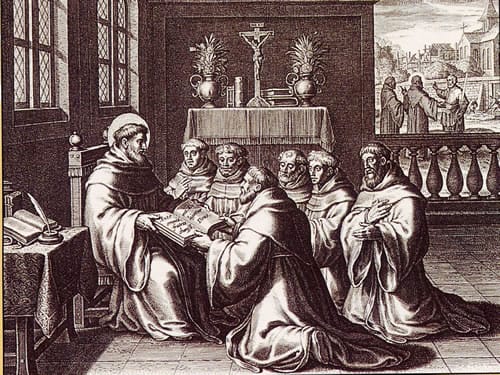According to the studies of specialists, the most known among whom are Luc Verheijen and G. Lawless, the authorship of the text that is traditionally known as the Rule of St. Augustine, is beyond doubt. This is so in spite of the fact that the work is not mentioned in Augustine’s Retractationes or in the list of books presented by Possidius, the first biographer of the Saint. The authorship is endorsed also by the history of the transmission of text, as well as by the internal testimonies of the text of the Rule, particularly the lexicological attestation (i.e., with reference to the signification and application of words) and those that concern the employment and version of the biblical quotations. As far as the transmission of the text is concerned, there exists a solid tradition of codices that are anterior to the XII century, the oldest version of which is traced to the first decades of the VII century. In relation to the language being employed, not only are there terms like emendatorius, which can be catalogued as one of Augustinian neologisms, but also numerous parallels to the language Augustine uses in his other works, particularly in De opere monachorum.
Other documents
It is important to underscore the fact that what is commonly known as the Rule (Praeceptum), should be differentiated from three other documents: the Ordo Monasterii (monastic rules and regulations); the Obiurgatio (reprimand Augustine gave to the nuns who were quarreling, after the death of his own sister who was the superior of the community, and as found in the letter 211, 1-4); the Regularis Informatio (feminine version of the Rule, as shown in letter 211, 5-16).
Date
The year 397 is the most widely accepted date of writing, in the manner that the Rule appeared to be the text that Augustine, now bishop of Hippo, wrote to regulate the life of the monks in the city. Others however point to the time between 400-401, by relating the Rule to the rebellious monks who lived in the vicinity of Carthage and who refused to work, arguing that they could not dedicate themselves to anything else that was not prayer. To this group of monks, and upon the request of bishop Aurelius of Carthage, St. Augustine wrote the grand work, De Opere Monachorum. This time would coincide also with the beginning or the possible publication of the first version of De sancta Virginitate. Still others are inclined to situate the Rule in between the years 426-427, the last years of St. Augustine and at the time when the bishop of Hippo had to give answers to the monks, first, of Hadrumento, where his works created great polemic, and also to the monks of Galia, among whom and among other things, a discussion on the role of grace in the mystery of salvation had taken place.
Contents
With reference to its contents, the Rule accentuates the importance of the community of goods, in the manner of the primitive community of Jerusalem and as described in the Acts of the Apostles (Acts 2, 44-47; 4, 32-35), together with the common life of chastity and obedience to an authority. One’s attention is called to the presence of a library in the Augustinian monastery, an element that signifies, on one hand, an elevated level of literacy, very much above that of the society at that time, and on the other hand, the importance that Augustine gives to learning, particularly the study of the Sacred Scriptures.
One can see social differences as far as the membership of the community is concerned, and as portrayed in the text of the Rule. There were rich and poor in the community of St. Augustine. With this and within the monastery St. Augustine began a true “social revolution”. In so well stratified a society like that of the late Roman Empire and in which social classes practically marked the destiny of the person, it was unthinkable for peoples of different social statuses to live together in the same place. Thus, some founders of monasteries, just like the case of Saint Jerome, thought of having aristocrats as members of their communities. St. Augustine, on the contrary, opens the monastery to everyone. No one should be excluded from the search of the “spiritual beauty” of God in the monastery, living in fraternal charity, experiencing the life itself of God Trinity-Community, having only one soul and one heart directed to God.
Organization
On the other hand, the moderate asceticism of the Rule is proverbial and its charity for the weakest and most needy is exquisite. With respect to the community life, fraternal correction is turned into a curative medicine that helps one to live in continuous process of conversion, to which the aid of fervent and attentive prayer is added. One can recognize within the monastery an organization, diverse offices, and services which the monks extend to one another, at all times safeguarding the value of what is common over what is private. Some 35 biblical citations, both from the Old and New Testaments, accompany the text as confirmation from the Sacred Scriptures of the nature of life of the monks.
Heritage
The impact of the Rule in the West was great. Thus, Eugipus assumes it totally. But the so-called Rule of the Master seems to have but little relation with the Augustinian Rule. The Rule of St. Benedict, on its part, somewhat depends a little bit on the Augustinian Rule. In contrast, the Rules of Cesar of Arles (towards the middle of the VI century) greatly depended on St. Augustine; the same is the case with the tradition of the southern Spain of Leander and Isidore of Seville. The Rule of St. Augustine also strongly influenced the medieval movements of the canons regular as well as those of the mendicants (Premonstratenses, Dominicans, Servites, etc). Actually there are more than 150 feminine and masculine religious families that follow and live the spirit of the Rule of St. Augustine.




